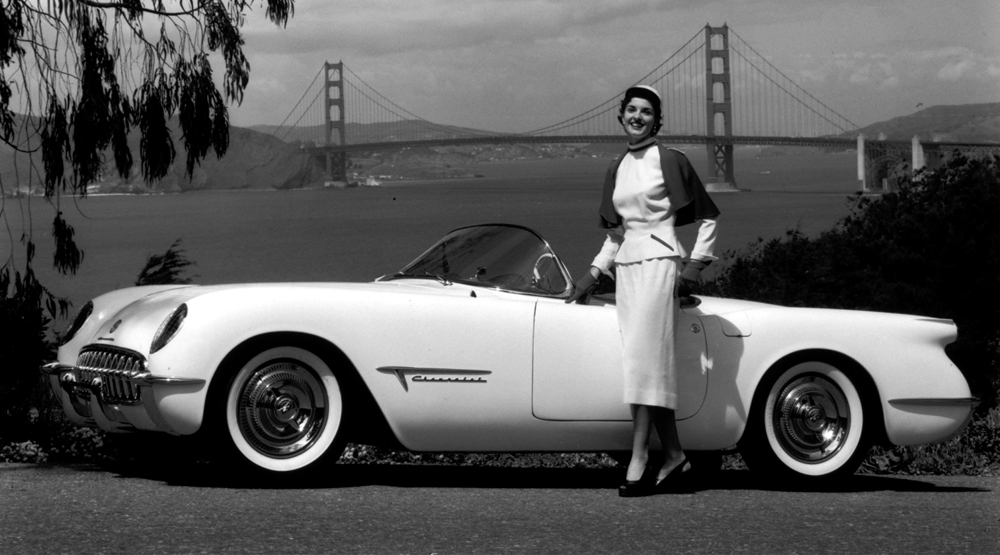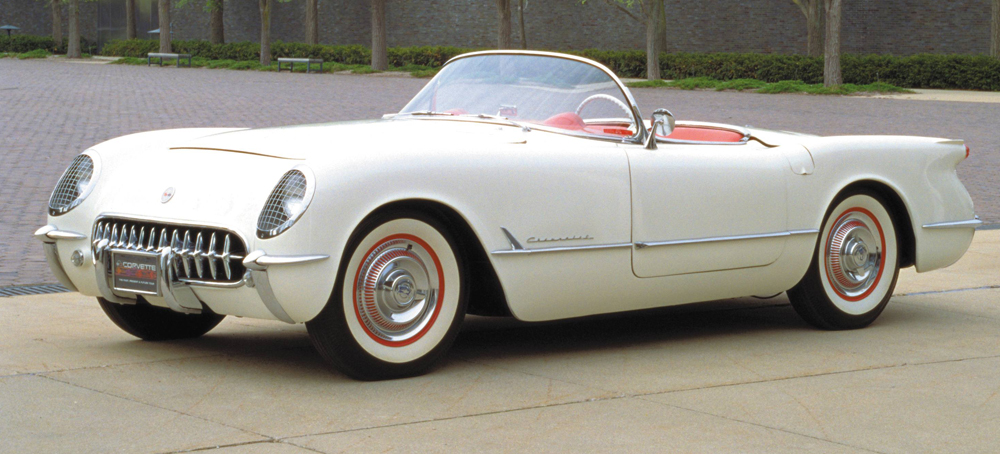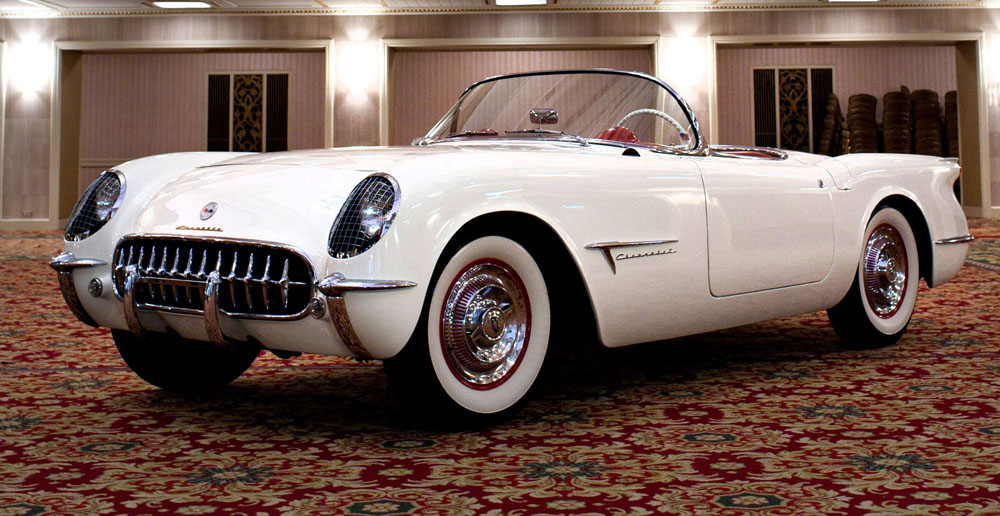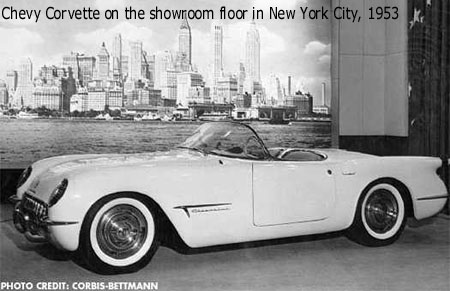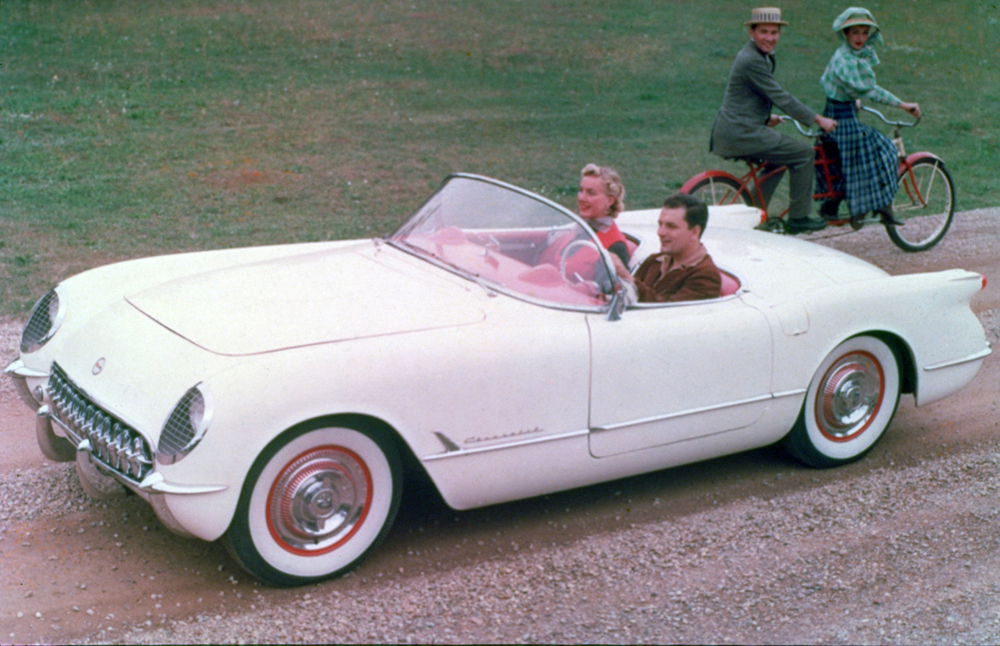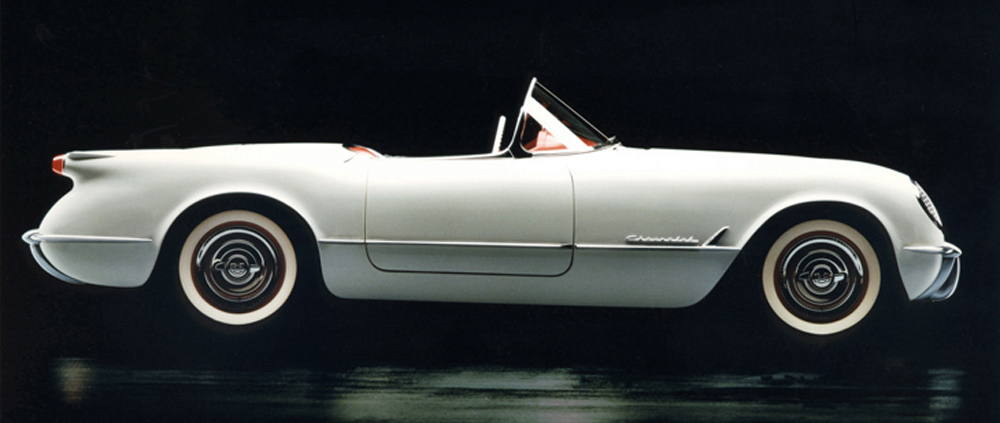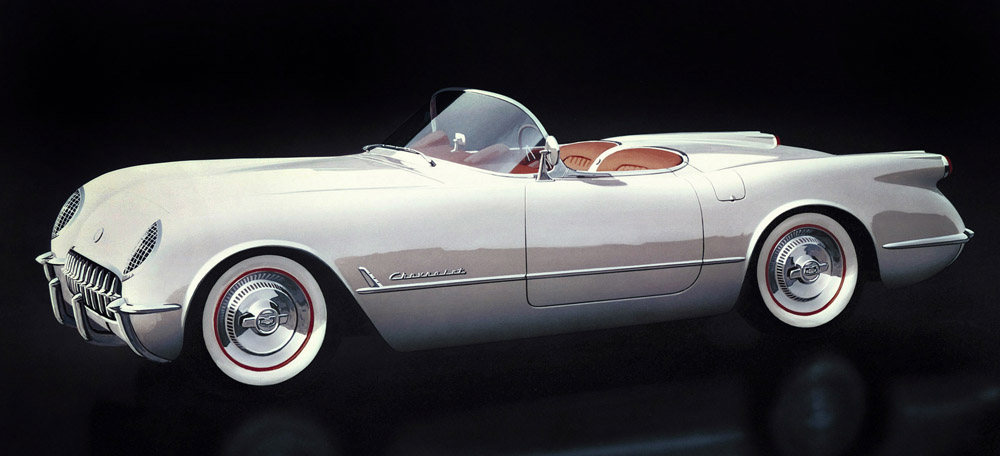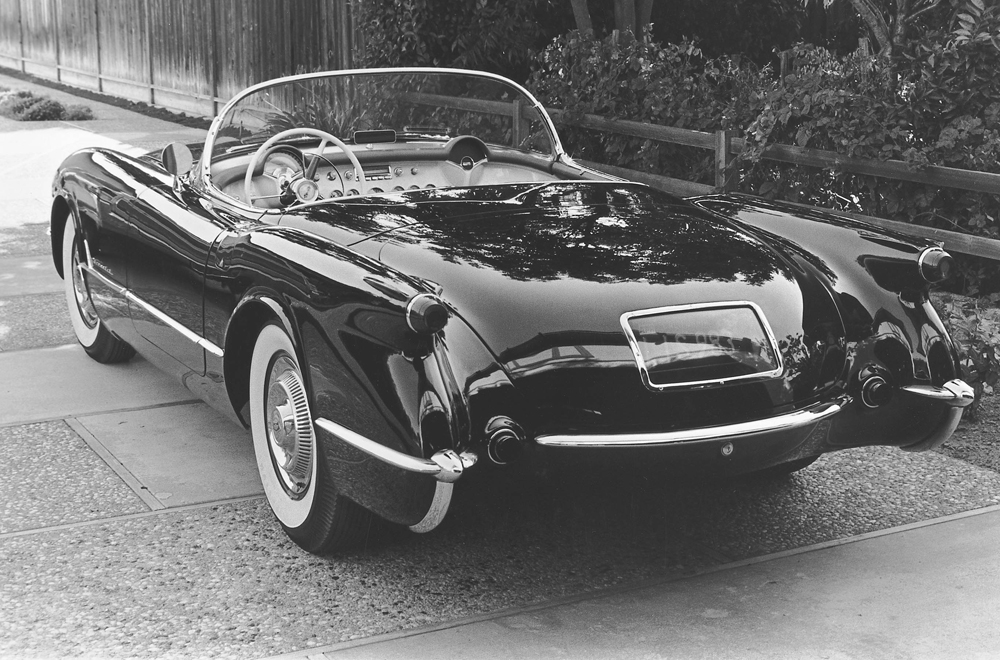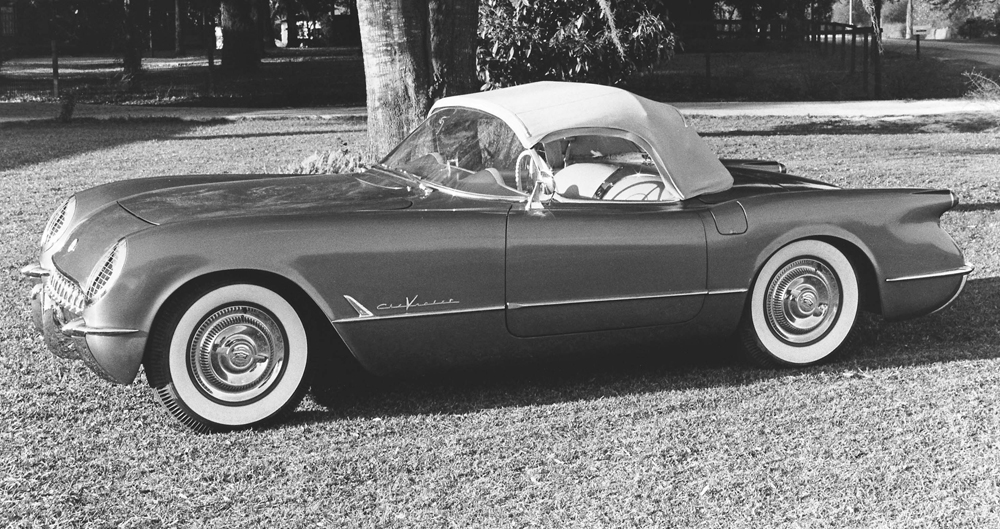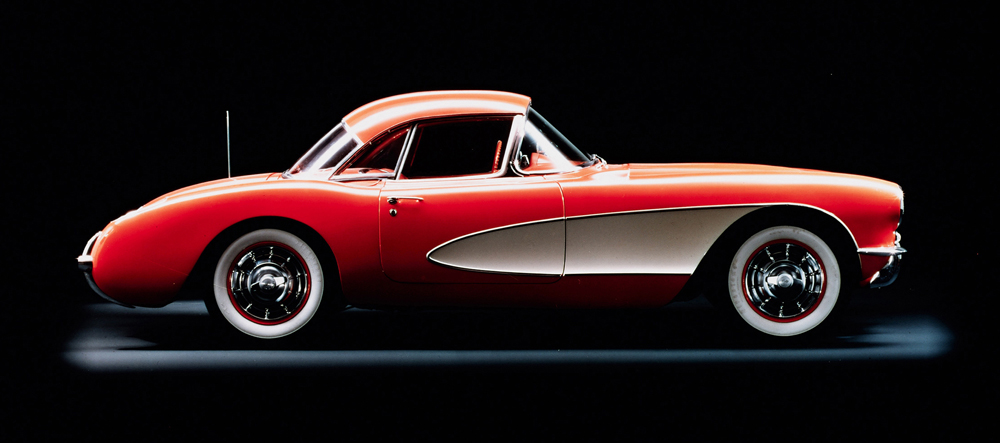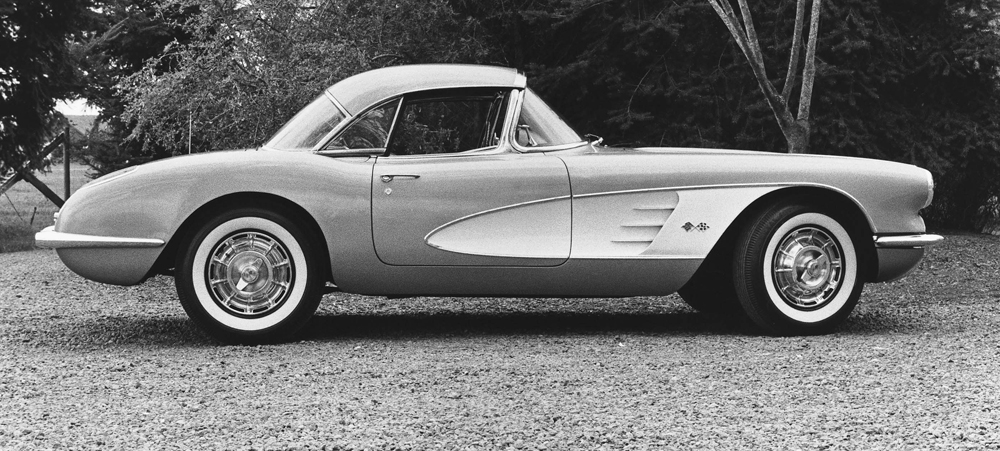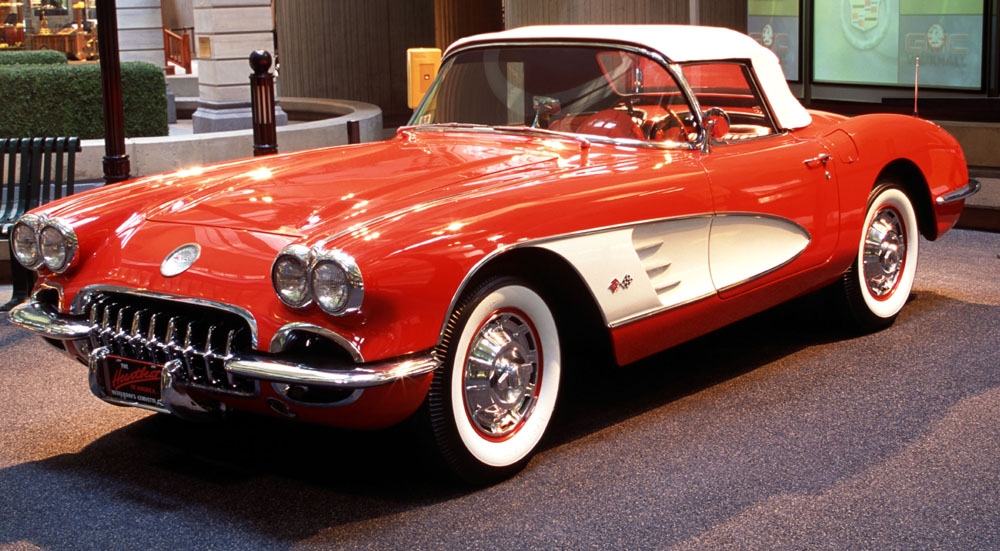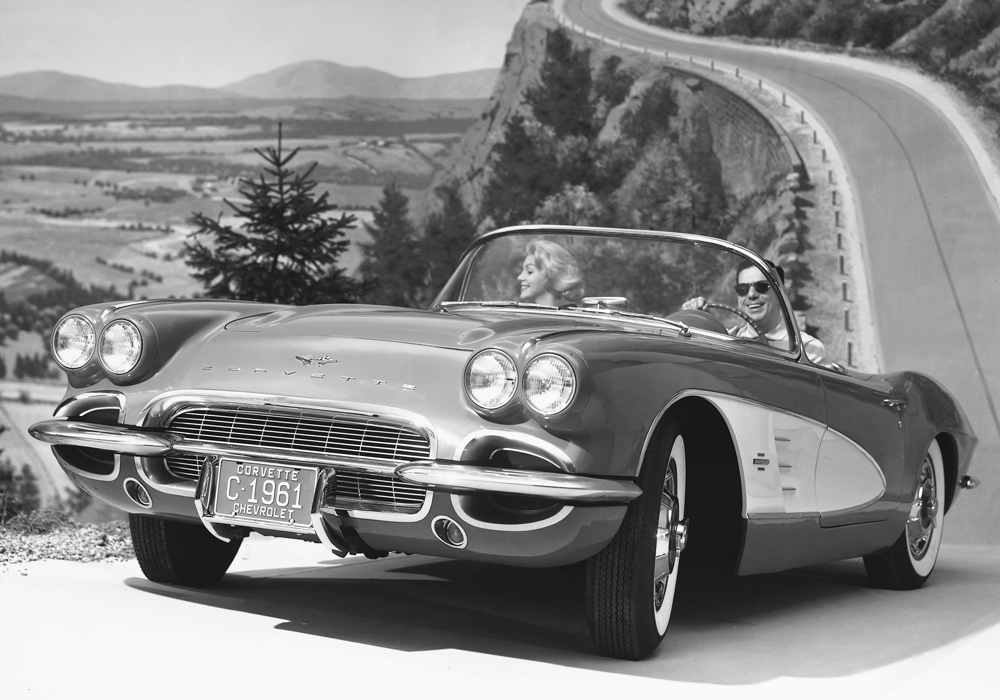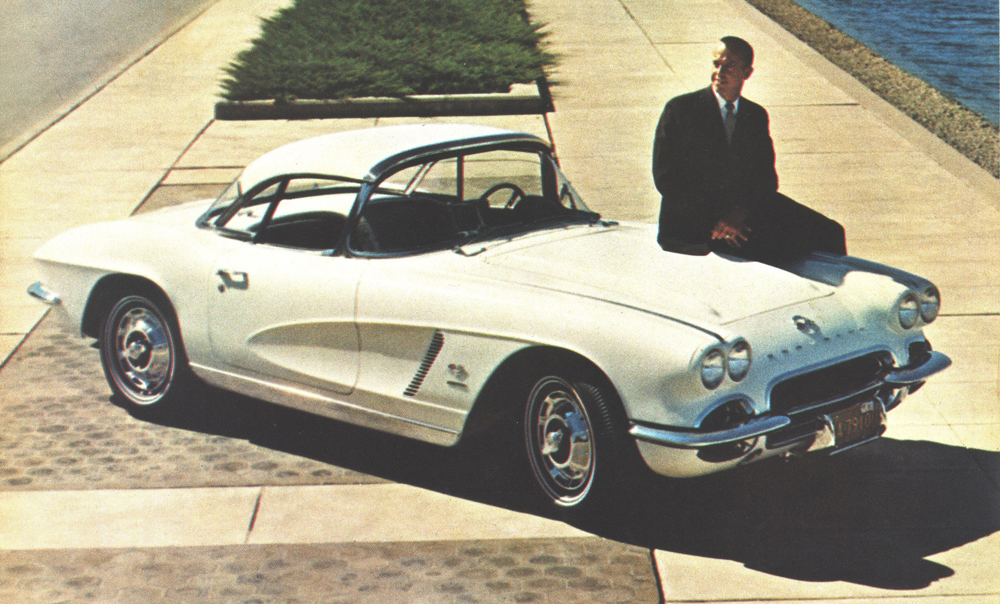|
|
|
|
1953 through 1962 First generation Corvette 1953
The first production Corvette is assembled in Flint, Mich., on June 30. In all, 300 of the fiberglass-bodied roadsters are built, all of them in Polo White with a Sportsman Red vinyl interior. All are powered by the "Blue Flame Six," a 6-cylinder in-line engine rated at 150 horsepower with three side-draft carburetors. Each car has a Powerglide automatic transmission and six-volt electrical system. Only two options are offered – a heater and an AM radio with the antenna sandwiched into the fiberglass trunk lid. In December, production of the Corvette moves to St. Louis, Mo.
The Little White Corvette ~ June 30 1953 The first Chevrolet Corvette, a white convertible roadster with a red interior, was produced in temporary facilities in Flint, Michigan. The Corvette was born as a dream car for the 1953 Motorama. The first all-fiberglass-bodied American sports car, the Vette turned heads with its release. The sleek lines of the 1953 edition are among the best produced by American car design. But underneath its exterior, the first Corvette's inner workings were less than impressive. They were comprised mostly of existing General Motors' (GM) parts, including a "Blue Flame" inline six-cylinder engine, a two-speed automatic transmission and the drum brakes from Chevrolet's regular car line. The Corvette was at best a half-hearted attempt at a sports car. Events, however, combined to keep the Chevrolet Corvette in production in spite of its dismal sales record early on. Ford's release of the T-Bird in 1954 necessitated the existence of the Corvette as GM's answer in the small, sporty market. GM gradually improved the vehicle's design until, by 1961, it was undoubtedly America's favorite sports car. Unique in American history in its longevity as a model, the Corvette has remained an impressive machine throughout its lifetime. In recent years, GM has been able to rank the Corvette among the world's elite sports cars in 0 to 60 times, top speed, and overall muscle. The Corvette's list price modestly remains half of its European competitors. 1953 Corvette Production Fun Facts:
(Above Photo) The original 1953 Chevrolet Corvette show car on display in the Waldorf Astoria ballroom Saturday, May 7, 2011 in New York, NY. (Below Photo)This vehicle first appeared publicly in January of 1953 at same hotel ballroom. Original 1953 Corvette logo's
"It was the first Corvette," says Harley Earl, 1953's two-seater sports car was intended to shake up Chevrolet's image, as well as battle the wave of sporty European imports flooding into the U.S.A. Initially though, the car wasn't a big hit, and it was only with the styling tweaks of a few years later that it became a true success.
1954 Three new exterior colors (Blue, Red and Black) and a new interior color (Beige) are offered Corvette production begins its first full model year in St. Louis. During the year, engine horsepower increases to 155. Nine options are now available; a beige interior is added plus three new exterior colors – blue, red and black.
1954 Corvette Corvair, Corvette Nomad and Corvette convertible coupe, see 1954 Corvette dream cars
1955
A new engine, the 195 HP, 265 cubic-inch V8 with a single four-barrel carburetor, gives a glimpse of performance to come. This is the first year Corvette offers a V8 engine, and the last year for a six-cylinder. Customers ordering V8 equipped Corvettes get the added bonus of a 12-volt electrical system. A three-speed manual transmission is also available.
1956
Corvette's styling is modified, and the new body features exposed headlamps, sculptured side coves and roll-up windows in place of the original car's side curtains. Factory-installed removable hardtops are offered for the first time, and a transistorized radio marks the advent of solid-state electronics on the Corvette. With the four-barrel carburetor, the 265 cubic-inch V8 has stock power of 210 hp, but an engine as powerful as 240 hp is available.
1957
Factory-installed fuel injection and an optional 4-speed manual transmission are offered. Corvettes equipped with fuel injection offer an optional tachometer mounted on top of the steering column. Thanks to fuel injection, the 283 cubic-inch V8 achieves 283 hp – the first engine in an American production car to offer one horsepower for every cubic inch of displacement.
1958
Corvette is extensively restyled. Dual headlamps, with separate high- and low-beam lamps, head the list of what's new. Other changes include a "louvered" hood, two chrome trunk strips, a new dash and new upholstery. Engine power is now as high as 290 hp and the speedometer increases to 160 mph.
1959
The exterior styling is similar to 1958, without the chrome trunk strips and hood ridges. The T-handle shifter makes its debut as do concave gage lenses and a storage bin under the passenger-side grab handle.
1960
Cast aluminum cylinder heads are added to the arsenal under the hood. An optional 315 hp 283 cubic inch V8 is available with the manual transmission exclusively. An aluminum radiator is available for the first time, but its use is limited to the high-lift cam engines. A stabilizer bar is added to the Corvette's rear suspension.
1961
The aluminum radiator becomes standard. Visual changes for the model year include new side emblems and the first use of four round taillamps, a trend evident in the 1997 Corvette. Exhaust tips exit below the body and the headlamp bezels are body color. A mesh appearance in the front grille replaces the heavy "teeth."
1962 Corvette's last year with exposed headlamps, a solid rear axle and a trunk opening. A 327 cubic inch V8 with horsepower ranging from 250 to 360, depending on the equipment, is introduced. The Powerglide automatic transmission has a new aluminum case. This is Corvette's last year with exposed headlamps, a solid rear axle and a trunk opening. The 1962 issue of Corvette News featured Alan B. Shepard with a white, 1962 Corvette coupe featuring a customized, space-age interior. (below) Alan B. Shepard (center) with GM Styling President William L. Mitchell (left) and Chevrolet General Manager Edward N. Cole (right) with Shepard's 1962 Corvette. In the background is the GM Design Center in Warren, Mich
Corvettes and Astronauts On May 5, 1961, Alan B. Shepard became the first American to travel into outer space. When he returned to terra firma, Shepard got behind the wheel of a Chevrolet Corvette – and the legends of America's favorite sports car and spacemen have been intertwined ever since. On May 7, 2011, approximately 30 of America's surviving astronauts are expected to gather at Cocoa Beach, Fla., where they will participate in a parade commemorating the 50th anniversary of Shepard's historic sub-orbital flight. Fittingly, they will be driven in Corvettes representing all six design generations built since the famed sports car's 1953 debut. "Each astronaut will ride in a Corvette from the generation current at the time of their mission," parade coordinator John T. R. Dillon III said. Dillon, a Safety Engineer at the Kennedy Space Center, is also a Corvette owner and member of the Cape Kennedy Corvette Club, which counted four astronauts among its original membership when it was founded in 1967. "All of the astronauts were test pilots back then; they flew performance aircraft and they moved into performance cars with a well-honed appreciation for handling, acceleration and so forth," Dillon said. Shepard brought along his 1957 Corvette when he reported for Space Program training in April, 1959...he would own at least 10 Corvettes in his lifetime. His enthusiasm for sports cars was shared by several of the other adventurous and dedicated young men who would train with him to become America's first astronauts. Shortly after Shepard's historic flight, then General Motors Executive Edward N. Cole presented the astronaut with a new, white, 1962 Corvette. The car had been outfitted by GM designers with a customized space-age interior. As GM did not routinely give away cars, the Corvette-astronaut connection might have become totally coincidental in the years that followed, had not Florida Chevrolet dealer Jim Rathmann stepped into the picture. After winning the 1960 Indianapolis 500 as a professional racer, Rathmann opened a Chevrolet-Cadillac dealership at Melbourne, Fla., near the Space Center, in 1961. Sensing that most of the spacemen were at heart Corvette types, Rathmann negotiated a special lease arrangement with Chevrolet to put them into the sports cars. Six of the Mercury astronauts would take Rathmann up on his Corvette offer. Stalwart family man John Glenn opted for a new Chevrolet station wagon instead. Glenn's wagon reportedly proved just the thing for those occasions when the seven astronauts needed to travel together. During an interview in 1998, Rathmann said, "Al Shepard was a racer...he was always wanting to be the fastest guy." That ambition was shared by fellow Mercury astronaut Virgil "Gus" Grissom. The two-lane blacktop duels fought by Shepard and Grissom in their big block-powered Corvettes would truly become the stuff of legend. In his quest for a competitive edge, Grissom had his last Corvette, a 1967 convertible, specially geared and modified to accept extra-wide rear racing tires. When Apollo 12 astronauts Dick Gordon, Charles Conrad and Alan Bean ordered new 1969 Corvettes through Rathmann, they asked that the identically equipped 390-hp 427 Stingray coupes be custom finished in a special black-accented Riverside Gold color scheme designed by Bean. A unique red, white and blue insignia was also added to the front fenders. NASA administrators reportedly fretted that a subsequently published LIFE Magazine photo of the space-suited Apollo 12 astronauts and their matching Corvettes could be misconstrued as a forbidden product endorsement. Even so, another photo of a trio of American astronauts with their Corvettes would appear in LIFE, during June 1971. Apollo 15 lunar mission crewmembers Jim Irwin, Al Worden and Dave Scott had been photographed with their Corvettes and a training version of the battery-powered Lunar Rover Vehicle (LRV) they would deliver to the moon. The "moon buggy," as it was also called, utilized a mobility system built by General Motors. The Apollo 15 crew Corvettes were each a different color...red, white and blue. Dual racing stripes on each car rounded out the American flag colors. The enduring association with America's astronauts has contributed greatly to the legend of the Corvette. "In the 1960s, astronauts were the American heroes that every child idolized and every adult respected," said Corvette historian and former Corvette Quarterly editor Jerry Burton. "That so many of them drove Corvettes really helped to establish Corvette as America's sports car." Released in 1979, author Tom Wolfe's bestselling book, "The Right Stuff," recounted the beginnings of America's space program. The book's success sparked a revival of interest in the original Mercury 7 space heroes—and their Corvette adventures. "Prior to that, astronaut-related Corvette stories were just kind of folklore...I think that it is thanks to Tom Wolfe that the Corvette is today so solidly cemented to the legend of the pioneering astronauts," said Burton. That association continues even today. The 1995 movie "Apollo 13" featured two era-authentic Corvettes, one of them used in a key scene featuring Tom Hanks as astronaut Jim Lovell. The 2009 movie "Star Trek XI" opens in the year 2245, with a 12-year old James T. Kirk driving a 280-year old 1965 Corvette Sting Ray. These stories, both fiction and non-fiction, contribute to the persistent urban legend that astronauts have owned more Corvettes than any other kind of car. That is likely a timeworn legacy of the first decade of the American Space Program. It is probably fair to say, however, that more astronauts have had more fun behind the wheel of America's Sports Car than in any other automobile.
|
|
|
